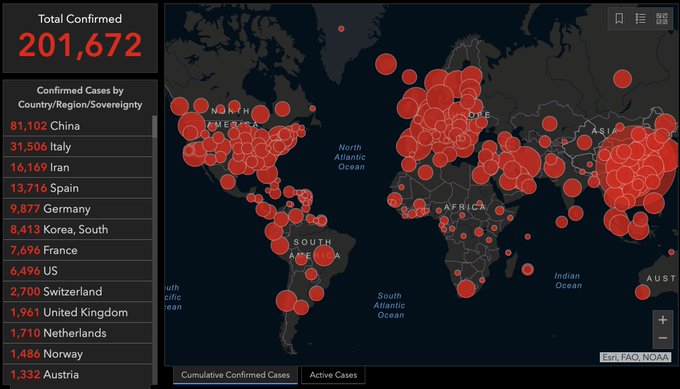COVID 19 Recent Updates
COVID-19 is caused by the virus SARS-CoV-2
- The recent coronavirus outbreak began in Wuhan, China, in December 2019.
- Known as SARS-CoV-2, the virus has resulted in more than 200,000 infections.
- COVID-19 has now been reported on every continent except Antarctica.
- The World Health Organization (WHO) publish their latest confirmed numbers on this situation dashboard every day.
- To read our feature article answering some of the most common questions and concerns surrounding COVID-19, click here.
03/18/2020 13:45 GMT — The number of COVID-19 cases worldwide surpassed 200,000
Overnight, the total number of #COVID19 cases has reached more than 200,000 globally.

This dashboard from @JohnsHopkins provides the latest figures regarding cases around the world. gisanddata.maps.arcgis.com/apps/opsdashbo…
16 people are talking about this
03/18/2020 12:18 GMT — Confusion about taking ibuprofen
Messages on social media have warned people to avoid using ibuprofen for treating the symptoms of COVID-19.
Experts in the United Kingdom explain that ibuprofen might lead to side effects or make symptoms worse, based on research around respiratory illness.
While there has not been any specific research around COVID-19 and ibuprofen yet, they recommend sticking to paracetamol/acetaminophen unless a healthcare professional advises otherwise.
Read more here.
03/18/2020 08:26 GMT — Study concludes SARS-CoV-2 can persist on surfaces for hours
A recent study, published in The New England Journal of Medicine, investigates how long the novel coronavirus can remain stable on a variety of surfaces.
They find that it can remain viable on stainless steel and plastic for up to 2–3 hours, in aerosols for up to 3 hours, on copper for 4 hours, and on cardboard for 24 hours.
Read more here.
03/18/2020 07:35 GMT – Why does SARS-CoV-2 spread so easily?
A recent feature, published by Medical News Today, asks why the novel coronavirus spreads so efficiently.
The article investigates how specific structural components of the virus interact with receptors on human cells. The feature also asks what these details mean for those who are working to create treatments and vaccines.
Read more here.
03/17/2020 15:52 GMT — CDC report first employee with COVID-19
According to a press release published by the CDC, laboratory testing has confirmed that one of their employees has been infected with SARS-CoV-2.
They explain that “This individual was not involved in the COVID-19 response, has not been present in the CDC workplace since March 6, and was asymptomatic at that time. Staff working in the same unit are teleworking while we will do a deep cleaning of the office space.”
03/17/2020 12:35 GMT — Coronavirus reaches Greenland
Yesterday, officials reported Greenland’s first case of COVID-19. The individual in question, who lives in Nuuk, the country’s capital, is in home isolation.
Greenland’s officials recommend that people avoid flying to or from Greenland.
Read more here.
03/16/2020 17:30 GMT — SARS-CoV-2 spreads fast, sometimes before symptoms appear
A new study, led by researchers at the University of Texas at Austin, calculated the “serial interval” of SARS-CoV-2, the virus that causes COVID-19.
The term serial interval refers to “the duration between symptom onset of a primary case and symptom onset of its secondary cases.”
The new study, which will appear in the journal Emerging Infectious Diseases, found that the average serial interval of COVID-19 is 4 days.
Study co-author Lauren Ancel Meyers, a professor of integrative biology at UT Austin, explains what this means.
“Ebola, with a serial interval of several weeks, is much easier to contain than influenza, with a serial interval of only a few days. Public health responders to Ebola outbreaks have much more time to identify and isolate cases before they infect others,” she says.
“The data suggest that this coronavirus may spread like the flu. That means we need to move quickly and aggressively to curb the emerging threat.”
The study also found that over 1 in 10 COVID-19 cases occurred as a result of being in contact with a person who was carrying the virus but showing no symptoms.
03/16/2020 15:55 GMT — Physicians find 20–30% drop in lung capacity in recovered patients
Doctors at the Hong Kong Hospital Authority have examined 12 patients who recovered from COVID-19 and found reduced lung capacity in two to three of them.
Dr. Owen Tsang Tak-yin, the Medical Director of the authority’s Infectious Disease Centre, says, “They gasp if they walk a bit more quickly.”
“Some patients might have around a drop of 20–30% in lung function,” adds Dr. Tsang Tak-yin.
“Some patients might have around a drop of 20–30% in lung function,” adds Dr. Tsang Tak-yin.
However, it is worth noting that it is too early to establish the long-term effects of COVID-19. The physicians did not carry out an extensive study, and it is too soon to tell whether these observations in 12 people will extend to the majority of people recovering.



Comments